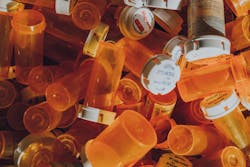Potential COVID-19 medication found among tapeworm drugs
Re-engineered compound fights both cytokine storm and viral replication, experiments show. A group of medications long prescribed to treat tapeworm has inspired a compound that shows two-pronged effectiveness against COVID-19 in laboratory studies, according to a new publication appearing online in the journal ACS Infection Disease.
The compound, part of a class of molecules called salicylanilides, was designed in the laboratory of Professor Kim Janda, PhD, the Ely R. Callaway, Jr. Professor of Chemistry and director of the Worm Institute for Research and Medicine at Scripps Research, in La Jolla, CA.
“It has been known for 10 or 15 years that salicylanilides work against certain viruses,” Janda says. “However, they tend to be gut-restricted and can have toxicity issues.”
Salicylanilides were first discovered in Germany in the 1950s and used to address worm infections in cattle. Versions including the drug niclosamide are used in animals and humans today to treat tapeworm. They have also been studied for anti-cancer and antimicrobial properties.
The modified salicylanilide compound that Janda created was one of about 60 that he built years ago for another project. When the SARS-CoV-2 virus became a global pandemic in early 2020, knowing that they may have antiviral properties, he started screening his old collection, first in cells with collaborators from Sorrento Therapeutics and The University of Texas Medical Branch, and later, after seeing promising results, working with Scripps Research immunologist John Teijaro, PhD, who conducted rodent studies.
One compound stood out. Dubbed simply “No. 11,” it differs from the commercial tapeworm medicines in key ways, including its ability to pass beyond the gut and be absorbed into the bloodstream—and without the worrisome toxicity.
“Niclosamide is basically digestive-track restricted, and that makes sense, because that’s where parasites reside,” Janda says. “For that reason, simple drug repurposing for a COVID treatment would be counterintuitive, as you want something that is readily bioavailable, yet does not possess the systemic toxicity that niclosamide has.”
About 80 percent of salicylanilide 11 passed into the bloodstream, compared to about 10 percent of the antiparasitic drug niclosamide, which has recently entered clinical trials as a COVID-19 treatment, Janda says.
The experiments showed that of the many modified salicylanilides he had built in his laboratory, No. 11 affected pandemic coronavirus infections in two ways. First, it interfered with how the virus deposited its genetic material into infected cells, a process called endocytosis. Endocytosis requires the virus to form a lipid-based packet around viral genes. The packet enters the infected cell and dissolves, so the infected cell’s protein-building machinery can read it and churn out new viral copies. No. 11 appears to prevent the packet’s dissolution.
Importantly, because it acts inside cells rather than on viral spikes, questions about whether it would work in new variants like Delta and Lambda aren’t a concern, he adds.
In addition, No. 11 helped quiet potentially toxic inflammation in the research animals, Janda says, which could be important for treating acute respiratory distress associated with life-threatening COVID infections. It reduced levels of interleukin 6, a signaling protein which is a key contributor of inflammation typically found in advanced stages of COVID-19.
Better medications against COVID-19 are urgently needed, as highly infectious new variants drive renewed surges of illness and death globally. But Janda says salicylanilide No. 11 was created long before the pandemic.
